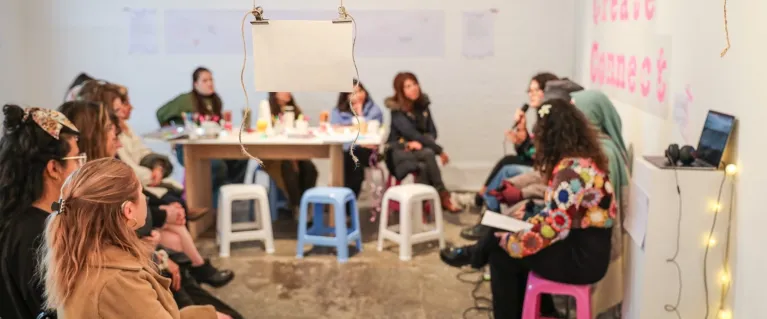
Co-Creative Communities: Service users co-design a co-operative membership platform
- Borough: Islington
- Organisations: Allie’s Art Club, Power With, Space4, Cubitt
- Topics: art, community engagement
Who we are
Allie’s Art Club is a grassroots community arts cooperative based in North London. Our mission is to create a culture of community, we aim to achieve this through providing fun and inclusive spaces for creative expression, collective care and cultural empowerment.
Co-Creative Communities was a co-design project that took place between April and November 2024. This experimental project provided a space for Allie’s community to engage in interactive learning, group discussions, arts activities and collective decision-making to co-design our Community Membership; a platform for local people to connect and make decisions about the services and resources our club provides.
Co-Creative Communities
Co-Creative Communities aimed to test inclusive, collaborative and participatory methods of community engagement. The project was funded by the Greater London Authority as part of the London Engagement Collaborative’s Good Ideas Fund, which aimed to support community organisations testing new engagement methodologies.
The project engaged eight service users through interactive learning, arts activities and co-design methods, consisting of three main phases:
April–May 2024:
- Internal training on co-design and co-production with Power With
- Participant recruitment & onboarding
June–August 2024:
- Series of 6 co-design workshops with service users at Space4
September–November 2024:
- Exhibition site visit & co-design session at Cubitt
- Public exhibition showcasing our learnings at Cubitt
Key outcomes for Allie's Art Club
The project produced three key outcomes for our organisation:
-
A Community Membership Offer: A platform for our community to connect and make decisions on what they want from our organisation.
-
A Community Membership Information Pack: An information booklet for our community to learn about our Community Membership and how to apply.
- Ambassador Membership Roles: An outline of participants’ future involvement as long-term leaders in our organisation.
Context and rationale
After registering as a Community Benefit Society in May 2023, we set a goal to develop a Community Membership to involve beneficiaries to shape and steer the club collaboratively. We conducted two consultations and a survey with beneficiaries to gain their input for our membership offer. However, we observed limitations to this approach. The pervasive ‘consultation fatigue’ experienced by many community members, coupled with minimal involvement in the design process, highlighted the need for us to deliver a Community Membership offer that is co-designed and led by beneficiaries.
Benefits of including service users
The benefits of including service users in the design and leadership of services include:
- helping to produce services that are suitable for service users
- supporting service users with differing needs and abilities to participate in making decisions
- membership that ensures service users make decisions using a process of sociocracy, where all service users consent to the decisions being made
- service users who are more likely to view services they’ve designed positively
- helping sustain empowering and meaningful engagement
- advancing inclusive, community-led approaches to Creative Health—using arts and cultural activities to improve wellbeing and reduce health inequalities.
Supportive and inclusive engagement methodology
-
Participants were paid the London Living Wage and commissioned £100 each for their exhibition art pieces.
-
Interactive learning, group discussions and arts activities enabled accessible and engaging co-design training and delivery.
-
Arts activities supported participants’ creativity, which helped with creative designs, was fun and supported positive feelings and wellbeing.
-
Participants need relevant information and skills to make informed decisions (co-operatives, power dynamics, conflict resolution, collaboration).
-
Important to build relationships between participants so they can work together collaboratively (check-ins, chats, group activities).
-
Trauma-informed and culturally inclusive facilitators.
- Final exhibition supported participants’ sense of pride and efficacy.
Conclusion
The project was very successful, with all outputs being carefully designed and receiving highly positive feedback from participants. However, there was potential for improvement if more time had been available to create more thorough designs. Moving forward, we will test run the community membership with Ambassador Members before launching it to the wider community.
Overall, the initiative supported participants' professional development, raised awareness of co-design and service-user-led platforms, and contributed to the development of the organisation's engagement strategy.
The changes we would like to see
As a result of this project, we would like to see policy-makers and service providers:
- include service users in the design of services they use
- support participants with differing needs and abilities
- provide sociable and supportive space where participants build relationships to support collective decision-making and collaboration
- develop sociocratic methods of collective decision-making
- provide training so participants can make informed decisions
- use arts activities and interactive discussions to make process accessible and engaging for participants.
To enable this change, we need:
- sustainable funding
- resources to test develop membership designs
- free and/or affordable spaces for membership meetings
- skills training and development, including:
- collective decision-making
- conflict resolution
- co-operative, non-hierarchical organisational structures
- accessible spaces and processes for people with disabilities, neurodivergence and mental health conditions.
Find out more
Get in touch
If you have any questions about Allie's Art Club, you can get in touch at [email protected].
Need a document on this page in an accessible format?
If you use assistive technology (such as a screen reader) and need a version of a PDF or other document on this page in a more accessible format, please get in touch via our online form and tell us which format you need.
It will also help us if you tell us which assistive technology you use. We’ll consider your request and get back to you in 5 working days.